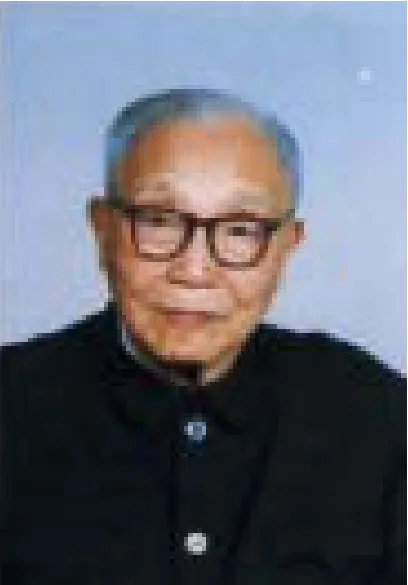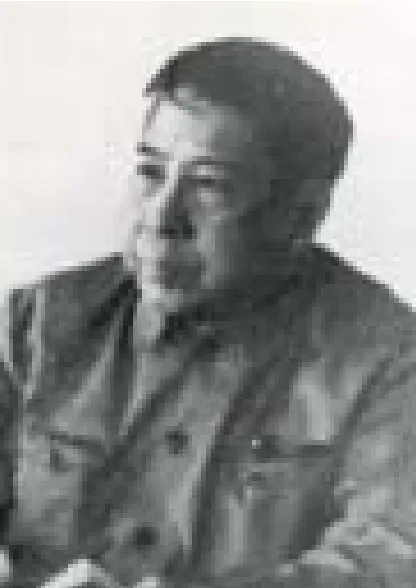院士風采

王大珩1915.02.26~2011.07.21
應用光學家。原籍江蘇蘇州,生于日本東京。1936年畢業于清華大學。中國科學院長春光學精密機械研究所研究員、所長、名譽所長。我國光學事業奠基人之一。為國防現代化研制各種大型光學觀測設備有突出貢獻;為我國的光學事業及計量科學的發展起了重要作用。50年代創辦了中國科學院儀器館,以后發展成為長春光學精密機械研究所。領導該所早期研制我國第一堝光學玻璃、第一臺電子顯微鏡、第一臺激光器,并使它成為國際知名的從事應用光學和光學工程的研究開發基地。1986年和王淦昌、陳芳允、楊嘉墀聯名,提出發展高技術的建議(“863”計劃)。還與王淦昌聯名倡議,促成了激光核聚變重大裝備的建設。提倡并組織學部委員主動為國家重大科技問題進行專題咨詢,頗有成效。1992年與其他五位學部委員倡議并促成中國工程院的成立。
1955年被選聘為中國科學院院士(學部委員)。
Applied opticist.Born in Suzhou, Jiangsu Province.Graduated from Tsinghua University in 1936.Research professor, director and honorary director, Changchun Institute of Optics and Fine Mechanics,Chinese Academy of Sciences.
Wang is one of the founders of optical science and technology in China.He has made outstanding contributions to the investigation and manufacture of various large and sophisticated optical devices for defense modernization in China and played a very important role in developing optical science and technology and in the progress of metrological science in China.In the 1950s, he founded the Laboratory for Instrument Technology ( the predecessor of Changchun Institute of Optics and Fine Mechanics, Chinese Academy of Sciences.) He directed the Institute to manufacture the first batch of optical glass, the first electron microscope and the first laser in China which made the Institute known worldwide as the center for applied optics and optics and optical engineering.Jointly with Profs.Wang Ganchang , Chen Fangyun and Yang Jiachi, he proposed the suggestion to develop high technology in China (the “863”Plan).He and Prof.Wang Ganchang also jointly initiated to build the national key device of laser fusion.He prompted and organized Member of the Chinese Academy of Sciences to play active roles in offering advises for national important topics of science and technology and achieved remarkable success.Jointly with other 5 Members of Chinese Academy of Engineering.In 1958, he was a leading awarded of the special prize of the National Science and Technology Progress Award.
He became Member of the Chinese Academy of Sciences in 1955.

王之璽1906.12.08~2001..0.20
冶金學家。河北行唐人。1931年畢業于天津北洋大學。冶金工業部咨詢委員,一級工程師。負責擬訂鞍鋼復工計劃,并參加工程施工,生產迅速恢復,獲一等功臣獎。首先組織創建了我國鋼鐵產品的技術標準,組織制定了全國鋼鐵冶煉的基本操作規程并建立技術監督制度;提出了攀枝花和包頭鐵礦綜合利用的課題,并負責組織攀枝花釩鈦鐵礦的高爐冶煉實驗工作,采用三段試驗方案取得成功,為攀枝花鋼鐵基地的建設創造了技術條件。負責組織制定冶金技術十年發展規劃,組織一些重大新技術的研究和推廣工作,如連續鑄鋼、貧赤鐵礦選礦、煉鐵高爐采用高壓高風溫、煉鋼真空處理、鋼材冷加工等。為推動冶金工業的技術進步,為中國金屬學會的創建和發展做出了貢獻。
1955年被選聘為中國科學院院士(學部委員)。
Metallurgist.Born in Xingtang, Hebei Province.Graduated from Tianjin Beiyang University in 1931.Member, Advisory Committee, and Grade-A senior engineer, Ministry of Metallurgical Industry.
Wang drew up restoration plans for Anshan Iron and Steel Works, took part in the engineering construction and enabled quick resumption of production, for which he got a first class merit citation.He was the first to organize the formulation of the National Technical Specifications of Iron and Steel Products in China.He organized and drew up national fundamental operating instructions for Chinese iron and steel metallurgical industries and set up a system of technical supervision.He put forward proposals for the comprehensive utilization of Panzhihua and Baotou iron ores.He was in charge of the experimental project for blast funace smelting of Panzhihua vanadium bearing titaniferous iron ores.He made great success in taking a three stage experimental scheme and met the technical requirements for the construction of Panzhihua iron and steel Industrial base.He was responsible for the mapping out of a ten-year plan for the development of metallurgical science and technology in China.He organized a series of important investigations on the research and development of modern technology, such as the continuous casting of steel, ore dressing of low grade hematite, intensification of blast furnace operation with high pressure and high temperature blowing, vacuum treatment in steel making, cold working of steel products, etc..He made great achievements in promoting the technological progress of China’s metallurgical industries and also contributed to the founding and development of the Chinese Society of Metals.
He became Member of the Chinese Academy of Sciences in 1955.

石志仁1897.03.01~1972.01.01
鐵路機械專家。河北樂亭人。1918年畢業于北京大學工科預科,1922年獲香港大學學士學位。1924年獲美國麻省理工學院碩士學位。鐵道部副部長、研究員。長期從事鐵路機務管理工作,主持設計和建立皇姑屯、戚墅堰和桂林等鐵路機廠。主持和參與制訂了我國機車車輛制造、維修、運營等一系列基本制度和輔助制度,參與了我國內燃機車、電力機車的設計、試制和生產以及燃氣輪機車試驗和京山線(天津—山海關間)自動閉塞試驗的組織領導工作,還參與了豐臺、蘇家屯和馱峰調車場的改造以及我國第一條環形鐵路實驗線的建設工作。
1955年被選聘為中國科學院院士(學部委員)。
Specialist in railway mechanics.Born in Leting, Hebei Province.Graduated from the Engineering Preparatory Course of Peking University in 1918.Received Bachelor degree from Hong Kong University in 1922, and MS from MIT, USA in 1924.Vice minister and research professor, Ministry of Railways.
Shi was engaged in the railway management for a long period of time.HE directed the design and construction of Huanggutun,Qishuyan, Guilin and other railway locomotive and rolling stock plants.He also directed and participated in mapping out a series of fundamental and supplementary systems for the manufacture,maintenance and operation of rolling stocks in China.Besides, he participated in the design, trial production and production of homemade diesel and electric locomotives as well as the test on gas turbine locomotives.He was one of the leaders and organizers on the test of automatic block system in Jing-shan Railway Line ( between Tianjin and Shanhaiguan ).He participated in the upgrading of hump yards in Fengtai and Sujiatun and the construction of the first loop railway test line in China.
He became Member of the Chinese Academy of Sciences in 1955.

葉渚沛1902.10.06~1971.11.24
冶金學家。祖籍福建廈門,生于菲律賓馬尼拉市。1925~1933年就讀于美國賓夕法尼亞大學。中國科學院化工冶金研究所研究員、所長。長期潛心于科學研究,善于運用多種科學和技術的綜合觀點,不斷提出解決國家建設中許多重大課題的意見和建議。倡導了化工冶金學和創建了化工冶金研究所。對中國采用當代鋼鐵冶金中的幾項最主要的新技術,提出了帶有方向性的預見;對中國幾個主要的鋼鐵基地和復雜礦綜合利用(包頭、攀枝花)以及一些有色金屬礦藏的開發利用,都提出了重要的建議。積極建議發展鋼鐵化肥聯合企業和豎爐煉磷,以迅速解決我國氮肥和磷肥短缺的局面。積極提出發展技術科學以及開展微粒學、計算機在冶金中的應用和超高溫新化工冶金過程的建議。
1955年被選聘為中國科學院院士(學部委員)。
Metallurgist.Born in Manila, the Philippines.Graduated from University of Pennsylvania, USA in 1925.Research professor and director, Institute of Chemical Metallurgy, Chinese Academy of Sciences.
In his life-long devotion to metallurgical science and technology,Ye was particularly well known for his ability in combining different disciplines to bear on problems of national significance and in formulating policies and strategies on their solution.He proposed the new discipline of applying chemical engineering principles to problems in extractive metallurgy.He established the Institute of Chemical Metallurgy, Chinese Academy of Sciences.He made some important suggestions in modernizing China’s iron and steel industry, such as the adoption of pressurized balst furnace with extra high- temperature blast, oxygen-blown steel converter, measures for utilizing China’s complex and low-grade iron ores, conservation of rare-earth in Baotou iron ore, and recovery of vanadium and titanium from Panzhihua iron ore.To utilize available resources for fertilizers, he advocated to develop fertilizer and iron and steel complex for recovering hydrogen from coke oven gas to make ammonia and blast furnace melting of low-grade phosphorous to make elemental phosphorous.He was an early proponent for the development of technological sciences, the application of particle study and computer to metal extraction and ultra-high temperature extractive metallurgy.
He became Member of the Chinese Academy of Sciences in 1955.

